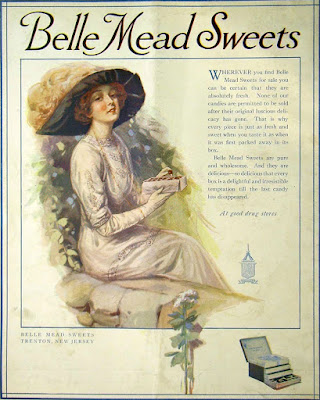When he got back, he called on two trusted employees that had worked for him at the Fair - M.G Rockhill and Scott Scammell - and presented an idea. They would build a small factory at Belle Mead and go into the fruit-preserving business. Despite none of the partners having any idea what fruit-preserving entailed, they acquired the land and began construction. It was only after the building was half up that they discovered there was no adequate source of raw materials - fruit! - within a thousand miles!
 |
| Hopewell, NJ factory, postcard circa 1904 |
What else could they do with the factory? After some thought Mr. Muirhead declared, "There is no candy on the market that really satisfies me." The selling point would be that all of the candy was absolutely pure - no artificial colorings or flavorings of any kind. The more subdued color of their candies, where the natural fruit juices supplied all of the hues, would be proof of the purity.
 |
| 1909 trade ad from Practical Druggist magazine |
Without any money to hire a sales force, the newly christened Belle Mead Sweets hit upon a plan of selling only through exclusive arrangements with individual druggists. Samples were sent out in the absolute best packaging they could afford and one establishment in each town was selected to be the authorized dealer.
 |
| Trenton factory circa 1908 from National Druggist magazine |
 |
| Trenton Factory circa 1908 from National Druggist magazine |
The plant completed in 1901 in Belle Mead was tiny. On the first floor, glass partitions separated Mr. Muirhead's office from the factory floor so that he could look out as the fruits were hand-dipped in chocolate and packed for shipment. The second floor held the dining room where managers and employees dined together at noon.
 |
| Trenton Factory circa 1912 from Electrical Record trade magazine |
Within a couple of years, Belle Mead Sweets had outgrown Belle Mead. Foreshadowing the challenges the US Army would face at their Belle Mead Depot 40 years later, the available workforce at Belle Mead was just too small for the growing manufacturer. A move to Hopewell for a few years was followed by a final move to Trenton, where John G. Muirhead handed over the company to his younger brother Harry - and probably went on another vacation!
Belle Mead Sweets seems to have gone out of business at some point in the 1940s.







